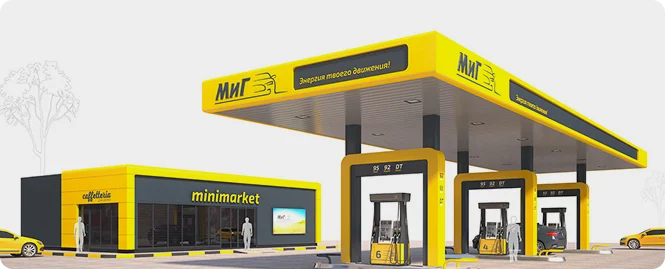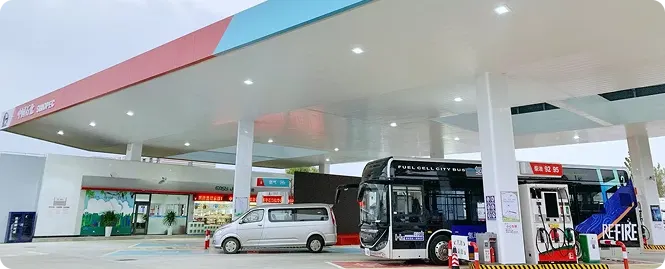How to Open a Gas Station in Alabama
Table of Contents
Key Takeaways
-
Opening a gas station in Alabama can be a profitable venture, but success depends on factors like location, demand, and competition.
-
Securing permits and licenses, understanding zoning laws, and ensuring environmental compliance are crucial steps before launching your gas station business.
-
Choosing between a sole proprietorship, LLC, or franchise, securing a business loan, and preparing financial projections help ensure long-term stability.
-
Managing inventory, fuel pricing, and facility maintenance while also incorporating convenience stores or additional services can boost profit margins.
-
Protecting your personal assets with the right business insurance, including an environmental contingency clause, helps mitigate financial risks.
Fueling up isn’t just for cars—it’s for business success, too! The gas station industry in Alabama offers a promising opportunity for business owners who are looking to tap into a steady stream of customers. With the rising fuel demand and the potential for added revenue through convenience stores, car washes, or repair services, a well-run gas station business can generate strong profit margins. However, success depends on factors like location, competition, and smart financial planning.
Jumping into the gas station business without having an action plan is like driving on empty fuel—you won’t get far. From securing the right permits and licenses to choosing between a franchise or independent ownership, every decision has an impact on your long-term success. Understanding startup costs, business loans, and environmental regulations is crucial. With a clear strategy, you can start a gas station that not only fuels vehicles but also fuels your financial growth.
Step 1: Researching the Market and Location
Finding the right location for your gas station is your roadmap for achieving long-term success. Areas that are near highways, commercial districts, and high-traffic intersections attract more customers. Being close to convenience stores can also increase foot traffic. Before choosing a site, reviewing zoning laws, environmental regulations, and accessibility ensures smooth business operations. Investing in a well-placed gas station business increases profit margins and creates opportunities for additional services like car washes or auto repairs.
A strong market analysis will help you determine whether an area has enough fuel demand to support opening a new gas station. Locations that have steady commuter traffic and limited fueling options present great opportunities to be successful. Studying competitor pricing, services, and promotions provides insight into customer expectations. Analyzing population density, local businesses, and economic activity can highlight the most promising areas for a profitable gas station with a competitive edge in the market.
Drivers in urban areas may prioritize speed and convenience, making efficient layouts and quick service important. In rural communities, customers may look for affordable fuel prices or additional services like auto repair. Understanding these regional buying habits can help you develop the right business strategy to attract and retain customers.
Step 2: Creating a Business Plan
A well-structured business plan provides the foundation for launching a successful gas station business. It should outline the startup costs, expected revenue, and growth strategy while helping secure funding from lenders or investors. A strong plan also ensures smooth operations by covering everything from permits and licenses to daily management. Taking the time to develop a detailed roadmap allows gas station owners to anticipate challenges and create strategies for long-term success in the fuel industry.
Creating an effective business plan should include financial projections, marketing strategies, and revenue goals to attract investors and guide operations. Running a thorough market analysis helps determine fuel demand and profit margins, while an operational strategy outlines employee needs and supplier contracts. A marketing strategy should detail local advertising, promotions, and loyalty programs to drive more customer engagement. Clearly defining these elements helps business owners start a gas station with a clear vision for profitability.
Success in the gas station business goes beyond the initial launch. Setting long-term goals can guarantee continued profitability and expansion for your business. Owners should plan for future upgrades, additional services like convenience stores, and potential franchise opportunities. Considering environmental regulations and emerging fuel trends like EV charging stations can keep the business relevant. A forward-thinking approach will help gas station owners easily adapt to industry changes and build a more sustainable and thriving business.
Step 3: Legal and Regulatory Requirements
Starting a gas station business in Alabama calls for obtaining the proper permits, licenses, and registrations first. Before operations can commence, business owners need a business license, fuel distributor license, and environmental permits. Registering for tax identification numbers and sales tax permits is equally necessary. If you are opening a gas station franchise, a franchise agreement may be required. Completing these legal steps helps ensure compliance and prevents delays in launching a profitable gas station.
Before constructing a gas station, business owners must ensure that the site is in compliance with the local zoning laws. Regulations determine where fuel stations can be built in terms of traffic flow, environmental impact, and community safety. Some areas may even require special approvals, which include a purchase agreement with an environmental contingency clause. Understanding these laws helps prevent legal complications and ensures a smooth approval process for a gas station business in Alabama.
Strict environmental regulations govern fuel storage and handling to prevent risks of contamination. Gas station owners must install leak detection systems, proper ventilation, and underground storage tanks that meet federal and state safety standards. Compliance with the Environmental Protection Agency (EPA) guidelines is essential to avoid penalties. Including an environmental contingency clause in purchase agreements ensures that past contamination issues are addressed before finalizing property deals. Staying compliant protects personal assets and ensures safe operations.
Step 4: Securing Financing
Launching a gas station business requires significant capital, but several financing options can help. Business owners can apply for a business loan from banks, credit unions, or private lenders. Seeking investors is another way to secure funding, especially for those looking to start a gas station franchise. Some opt for Small Business Administration (SBA) loans, which offer lower interest rates and flexible terms. Exploring multiple options ensures financial stability and a strong foundation for success.
A well-structured business plan can make or break your case when applying for loans or attracting investors. It should include financial projections, startup costs, profit margins, and operational expenses. Lenders will also review personal assets, credit history, and collateral before they approve funding. Detailed income statements, balance sheets, and cash flow forecasts strengthen your case. Business owners who present a solid financial plan are more likely to secure the necessary funds for their gas station business.
Alabama offers several government programs and grants to support small business owners navigating their way in the fuel industry. The Small Business Administration (SBA) provides funding assistance, while state-level initiatives help with startup costs. Some programs focus on environmental compliance, offering eco-friendly fuel storage solutions grants. Entrepreneurs should research local business development organizations and economic incentives to ease financial burdens. Taking advantage of these resources can significantly reduce initial investment costs and improve long-term profitability.
Step 5: Selecting the Right Equipment and Suppliers
Running a gas station business requires investing in the right equipment for smooth operations. This can include fuel dispensers, underground storage tanks, and POS systems that are necessary for daily transactions. Fire suppression systems, security cameras, and proper lighting ensure safety and compliance with regulations. Additionally, inventory tracking systems help manage fuel levels and prevent losses. Investing in high-quality equipment minimizes maintenance costs, improves efficiency, and helps gas station owners provide reliable service to their customers.
Partnering with reliable fuel suppliers ensures consistent fuel availability and stable pricing. Business owners should compare their supply agreements, contract terms, and delivery schedules first to secure the best deal. Some gas station businesses go for more branded suppliers for marketing benefits, while others prefer independent distributors for flexibility. Contracts should include price protection clauses and supply guarantees to manage through market fluctuations. Building strong supplier relationships helps optimize profit margins and ensure uninterrupted operations.
Adding services like a convenience store, car wash, or auto repair shop can significantly increase revenue. Many gas station businesses attract customers by offering snacks, beverages, and everyday essentials. Additional services like ATM access, lottery sales, and electric vehicle charging stations help diversify income. Conducting a market analysis ensures the right mix of services based on local demand. Expanding beyond fuel sales creates multiple income streams, making the gas station business more resilient and profitable.
Step 6: Building and Designing the Gas Station
Building a gas station and convenience store calls for detailed planning to ensure functionality and efficiency. The layout should optimize traffic flow, making it easy for drivers to enter, refuel, and exit without congestion. A well-placed convenience store encourages additional purchases, boosting profit margins. Factors such as canopy placement, fueling islands, lighting, and signage contribute to visibility and accessibility. Investing in durable materials and efficient designs reduces maintenance costs and enhances the station’s long-term viability.
Adhering to the set building codes, zoning laws, and safety regulations is critical for a smooth gas station construction process. Having proper ventilation, spill containment systems and fire suppression equipment help maintain safety standards. Ensuring ADA-compliant facilities are available along with clear pathways improves accessibility for all customers. Additionally, environmental regulations must be met, including proper fuel storage and leak detection systems. Meeting these requirements reduces liabilities and ensures compliance with local and state laws.
A well-designed gas station increases revenue and customer satisfaction. A spacious forecourt, clear signage, and strategically placed fuel dispensers improve efficiency. A bright, organized convenience store encourages impulse buys, while clean restrooms and seating keep customers happy. A thoughtful store layout and ample parking ensure a welcoming and user-friendly experience.
Step 7: Hiring and Training Employees
A successful gas station requires a reliable and efficient team for customer service, management, and maintenance. Hiring friendly and responsible employees enhances customer satisfaction and daily operations. Look for candidates with experience in retail, fuel handling, or food service. Background checks and reference verification help ensure trustworthiness. Offering competitive wages, benefits, and growth opportunities attracts dedicated staff. A clear hiring process with well-defined job roles ensures a smooth-running business and minimizes high employee turnover rates.
Proper training and management is essential for gas station employees in order to ensure safety, efficiency, and compliance. Staff should be trained in handling fuel, operating POS systems, and managing store inventory. Emphasizing customer service skills helps in enhancing the overall experience for visitors. Employees must also understand emergency procedures, fire safety, and theft prevention. Regular training sessions, certifications, and refresher courses keep staff well-prepared, ensuring a safe and well-functioning gas station and convenience store.
A structured scheduling and payroll system keeps operations running smoothly. Implementing rotational shifts ensures adequate coverage during peak hours. Digital time-tracking tools help manage attendance and reduce payroll errors. Offering direct deposit, employee benefits, and performance-based incentives boosts motivation and reduces turnover. Efficient payroll management ensures compliance with wage laws.
Step 8: Marketing and Promotion
Promoting the grand opening of your gas station is crucial for attracting customers and establishing a strong local presence. Invest in eye-catching signage, direct mail campaigns, and newspaper ads to spread the word. Offer limited-time discounts on fuel and store items to draw in new customers. Hosting a grand opening event with attractive giveaways, music, and local vendors can generate buzz. Partnering with radio stations and local influencers further enhances visibility and encourages word-of-mouth marketing.
A strong digital marketing strategy helps keep customer engagement high. Leverage social media platforms like Facebook or Instagram to share new promotions, fuel discounts, and convenience store deals. Implementing a loyalty program with fuel points or discounts on repeat purchases keeps customers returning. Running seasonal promotions and limited-time offers boosts sales. Offering mobile payment options and integrating discounts within a station-branded app further enhances convenience and encourages repeat visits from your target audience.
Collaborating with local businesses, schools, and community organizations strengthens your station’s reputation: sponsor local events, sports teams, or charity drives to create goodwill. Offer mutual discounts to cross-promote with nearby restaurants, auto repair shops, or retail stores. Becoming a recognized name in the community builds customer trust and long-term loyalty.
Step 9: Ongoing Operations and Maintenance
Running a successful gas station requires efficient day-to-day management. Some key responsibilities include keeping track of fuel levels, monitoring store inventory, and ensuring that stocked products meet customer demands. Fuel pricing should be competitive yet profitable, requiring close monitoring of market trends and competitor rates. Implementing modern POS systems streamlines transactions and enhances customer experience. Regular staff meetings help keep employees informed about daily goals, promotions, and customer service expectations, ensuring smooth operations.
A well-maintained gas station ensures customer safety and business longevity. Regular equipment inspections, from fuel dispensers to storage tanks, help prevent any malfunctions. Compliance with local and federal safety regulations, including fire safety measures and hazardous material handling, is essential. Keeping the premises clean, well-lit, and accessible enhances customer trust. Regular safety training for employees, including spill management and emergency response protocols, minimizes risks and ensures a safe working environment for both staff and customers.
Listening to customer feedback will help refine your service quality and build brand loyalty. Encouraging customers to leave reviews or surveys identifies areas needing improvement. Addressing complaints quickly and effectively demonstrates a commitment to excellent service. Offering rewards for customer suggestions fosters engagement and ensures a continuously improving customer experience.
Conclusion
Starting up a gas station in Alabama requires strategic planning and compliance. From choosing the right location and securing permits and licenses to developing a business plan and securing financing, every step is crucial. Establishing supplier partnerships, hiring staff, and implementing marketing strategies ensure a successful launch and long-term profitability.
Insurance protects gas station owners from financial risks like property damage, liability claims, and environmental hazards. Unexpected incidents can occur with fuel storage and high customer traffic. Policies like general liability, workers’ compensation, and business interruption help protect business assets, ensure compliance, and provide peace of mind for long-term stability.










